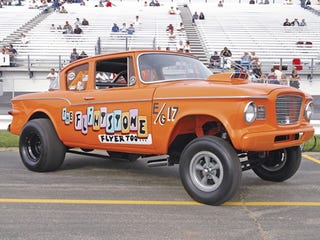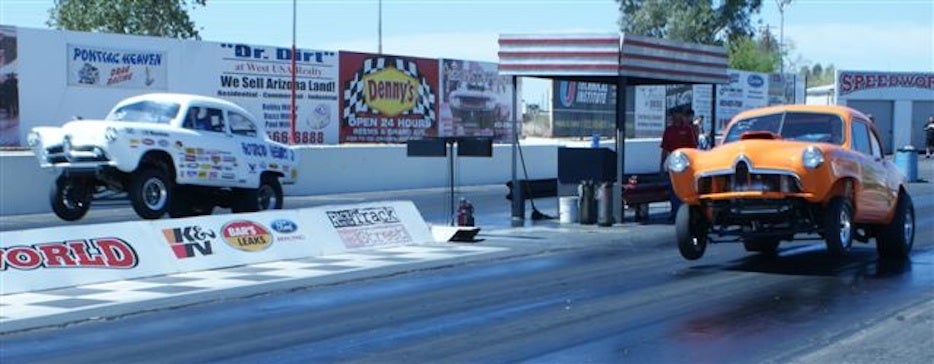What is used to make the arms are the wheelie bars ?
I see in a lot of photos that the front end is jacked way up in the air and in others they are very low. What is with this ?
1/32 Gasser Question
13 posts
• Page 1 of 1
Re: 1/32 Gasser Question
Austin -
As Dave mentioned - the nose in the air was typical of the Gasser cars of the 60's - with a number of them having straight axles with leaf springs installed, fender well exit headers, etc.
In fact, most of the Gassers not only sat high in the front - but in the back as well.
Here are some example shots showing the solid front axles, and general stances...
Enjoy!





As Dave mentioned - the nose in the air was typical of the Gasser cars of the 60's - with a number of them having straight axles with leaf springs installed, fender well exit headers, etc.
In fact, most of the Gassers not only sat high in the front - but in the back as well.
Here are some example shots showing the solid front axles, and general stances...
Enjoy!





-

TuscoTodd - HRW Bouncer
- Posts: 7145
- Joined: Sat Aug 17, 2013 11:25 am
- Location: Rural Ohio
Re: 1/32 Gasser Question
Those warm my heart. Thanks, Todd.
The Studebaker Lark is hilarious. They are all gorgeous cars.
The Studebaker Lark is hilarious. They are all gorgeous cars.
-

waaytoomuchintothis - "Seasoned SlotRacer"
- Posts: 7576
- Joined: Wed Aug 29, 2012 7:16 pm
- Location: Chesterfield, Virginia
Re: 1/32 Gasser Question
Thanks, Looks like I will be jacking up my car
- Austin
- HRW SlotCar Veteran!
- Posts: 1253
- Joined: Thu Sep 06, 2012 4:08 am
- Location: Merrimack, NH
Re: 1/32 Gasser Question
Thanks for posting those pics Todd.
I'd been wondering what to use for wheel inserts, and now that I seen the wheels on these cars, I know what to use now... :D
I'd been wondering what to use for wheel inserts, and now that I seen the wheels on these cars, I know what to use now... :D
-

nhdungeonracer - SCC Mechanic
- Posts: 1776
- Joined: Tue Sep 04, 2012 7:00 am
Re: 1/32 Gasser Question
"Back in the day" . . . . . . someone came up with a theory that having the centerline of the crankshaft at 24 inches above the track's surface would aid in starting line traction. The short life span of this would say their theory was full of . . . . . holes? However they still intrigue me with their oddball appearance.
One day I had a front row seat to the back end of one of these cars. I owned a 62 Oldsmobile "Jetfire". It had a 215 cubic inch V-8 with a 1-bbl sidedraft carb and a turbocharger. I had pulled the front and rear bumpers and sent them off to the chrome shop to be re-done. I just had to choose that weekend to visit my then home track at Englishtown, NJ. As I went through tech, I saw them classify my car as a D/GS vehicle. :angry-screaming:
I never knew how much harder a car leaves the starting line with a set of slicks and a good suspension. After one trip down the track, I decided it was much better to become a spectator rather then a spectacle
!
One day I had a front row seat to the back end of one of these cars. I owned a 62 Oldsmobile "Jetfire". It had a 215 cubic inch V-8 with a 1-bbl sidedraft carb and a turbocharger. I had pulled the front and rear bumpers and sent them off to the chrome shop to be re-done. I just had to choose that weekend to visit my then home track at Englishtown, NJ. As I went through tech, I saw them classify my car as a D/GS vehicle. :angry-screaming:
I never knew how much harder a car leaves the starting line with a set of slicks and a good suspension. After one trip down the track, I decided it was much better to become a spectator rather then a spectacle
!
-

Florida_Slotter - Scratch Build Guru
- Posts: 1941
- Joined: Wed Sep 05, 2012 4:08 pm
- Location: Florida
Re: 1/32 Gasser Question
Never heard the 24" theory before, but i dont doubt it a bit! I used to own and run a 40 Chevy coupe, that ran under the name "Frustration II" It was a B/G Car in the late sixties. I got to know the original builder of the car, and he showed me how he/ they used to set up the Ladder bars for gassers back then.
They would use two floor jacks on either side of the car, and lift it off the ground with a beam run underneath. when they found the balance point, they would mount the front mount for the ladder bars 6" ahead of that balance point. it would cause lift when the rear axle rotated,and would push down hard on the very hard compound slicks of the day. If you notice through pictures of the era, As tire science came around the nose of the cars came down as well. transfer of weight for traction was not as necessary as it was with hard compound tires.
The tall rear slicks dictated the front off the car be raised above the centerline of the rear axle to aid this transfer of weight for traction, so basically, the taller the rear tire was, the higher the front ends went. Most of these cars were converted from street cars,and lesser drag classes, so as the engine power grew, the tires did too, and thats where the rear wheel wells got cut out. If any of you have ever restored one of these old cars, you know that the technology of that era would scare the hell out of most folks. One of many i have been involved with, had aluminum tubing for all the steering arms to save weight. Not much thicker than a lawn chair framework! all painted black to get past inspection, and save maybe five pounds.
its a wonder we ever lived through those racing years!
Bob
They would use two floor jacks on either side of the car, and lift it off the ground with a beam run underneath. when they found the balance point, they would mount the front mount for the ladder bars 6" ahead of that balance point. it would cause lift when the rear axle rotated,and would push down hard on the very hard compound slicks of the day. If you notice through pictures of the era, As tire science came around the nose of the cars came down as well. transfer of weight for traction was not as necessary as it was with hard compound tires.
The tall rear slicks dictated the front off the car be raised above the centerline of the rear axle to aid this transfer of weight for traction, so basically, the taller the rear tire was, the higher the front ends went. Most of these cars were converted from street cars,and lesser drag classes, so as the engine power grew, the tires did too, and thats where the rear wheel wells got cut out. If any of you have ever restored one of these old cars, you know that the technology of that era would scare the hell out of most folks. One of many i have been involved with, had aluminum tubing for all the steering arms to save weight. Not much thicker than a lawn chair framework! all painted black to get past inspection, and save maybe five pounds.
its a wonder we ever lived through those racing years!
Bob
-

btaylor - Uncle Bob
- Posts: 4519
- Joined: Mon Mar 24, 2014 3:50 am
Re: 1/32 Gasser Question
That is some cool background info Bob!
Thanks for sharing!
Oh and aluminum tubing steering components?!? :scared-eek:
Thanks for sharing!
Oh and aluminum tubing steering components?!? :scared-eek:
-

TuscoTodd - HRW Bouncer
- Posts: 7145
- Joined: Sat Aug 17, 2013 11:25 am
- Location: Rural Ohio
Re: 1/32 Gasser Question
Thought this was a pretty entertaining and somewhat fitting episode... :D
-

TuscoTodd - HRW Bouncer
- Posts: 7145
- Joined: Sat Aug 17, 2013 11:25 am
- Location: Rural Ohio
Re: 1/32 Gasser Question
Todd: loved the Roadkill
- Austin
- HRW SlotCar Veteran!
- Posts: 1253
- Joined: Thu Sep 06, 2012 4:08 am
- Location: Merrimack, NH
Re: 1/32 Gasser Question
If you ever drove a straight axle car on the HWY very much you would understand why the fad faded away.
- Mitch58
- HRW SlotCar Veteran!
- Posts: 376
- Joined: Fri Jan 17, 2014 7:22 pm
Re: 1/32 Gasser Question
Getting all jacked up
proline fiber chassis, front wheels, & tires
M/T body
SCC rear wheels
Pauls rear tires


proline fiber chassis, front wheels, & tires
M/T body
SCC rear wheels
Pauls rear tires


- Austin
- HRW SlotCar Veteran!
- Posts: 1253
- Joined: Thu Sep 06, 2012 4:08 am
- Location: Merrimack, NH
Re: 1/32 Gasser Question
Really like how that is shaping up! :D
-

TuscoTodd - HRW Bouncer
- Posts: 7145
- Joined: Sat Aug 17, 2013 11:25 am
- Location: Rural Ohio
13 posts
• Page 1 of 1
Who is online
Users browsing this forum: No registered users and 5 guests
